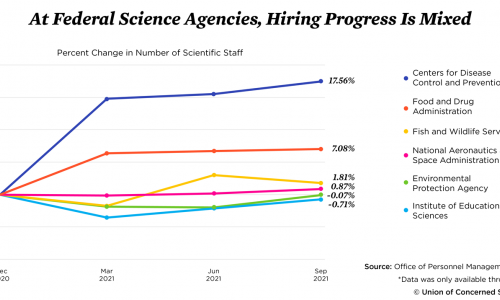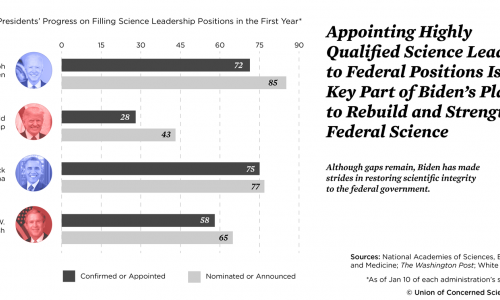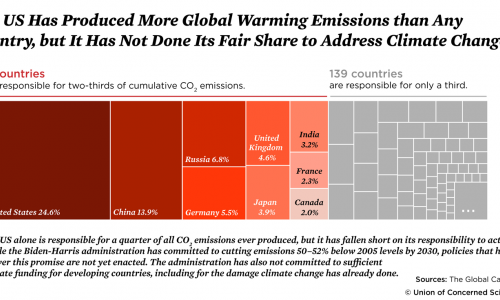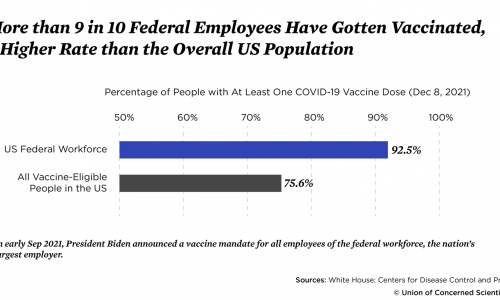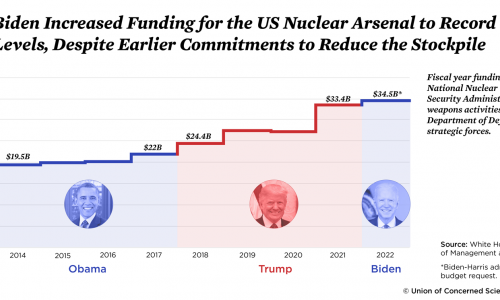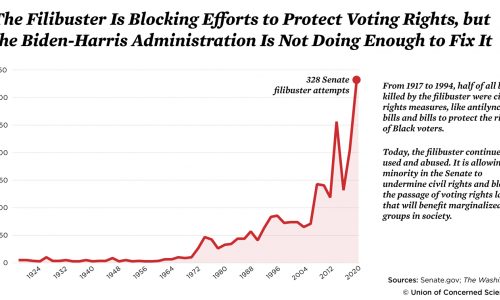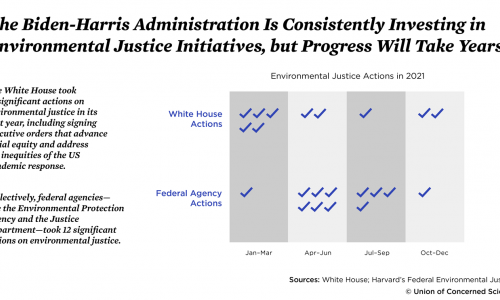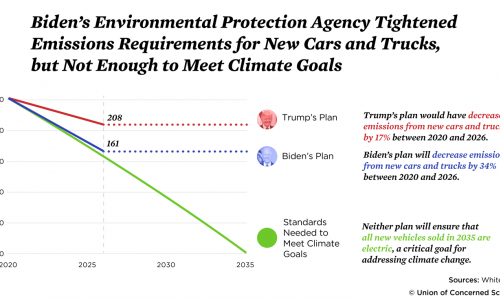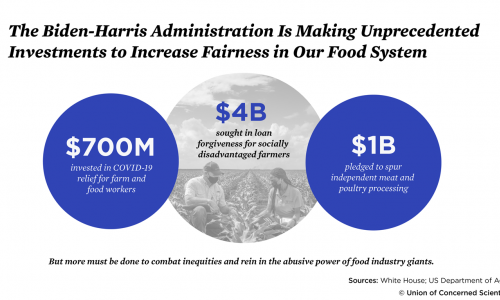As the Biden administration's first year draws to a close, how much progress has been made to restore science-based decisionmaking in the federal government? To fight climate change and promote environmental justice? Or to combat the pandemic? What key work still remains?
In this online report, UCS offers a detailed assessment of what has been accomplished and what pledges remain unfulfilled so far. We review progress in rehiring government scientists across different federal agencies. We track efforts to roll back initiatives from the previous administration that threatened our environment, exacerbated climate change, and impaired scientific integrity in governmental decisionmaking. And we highlight the most important areas where more work urgently needs to be done.
All told, we offer assessments across nine issue areas: the federal workforce, scientific integrity, environmental justice, the COVID-19 pandemic, democracy reform, climate change, clean transportation, food and agriculture, and nuclear weapons.
One Year of Science Under Biden
When Joe Biden was sworn in as president one year ago, his administration took the helm of a troubled nation. COVID-19 had killed 400,000 people. The pandemic-battered economy had shed millions of jobs. The nation reeled from the January 6 insurrection. The climate crisis loomed.
On the campaign trail, President Biden promised to mend the country's wounds. So far, the Biden-Harris administration has made big strides: it has recommitted the US to fight climate change alongside global partners, worked to combat the pandemic, and uplifted the role of science in government.
But more must be done. In the clear-eyed assessment below, we outline what the administration has accomplished—and what it must still do across nine issue areas: the federal scientific workforce, scientific integrity, climate change, COVID-19 response, nuclear weapons, protecting democracy, environmental justice, clean vehicles, and food and agriculture.
The Federal Scientific Workforce
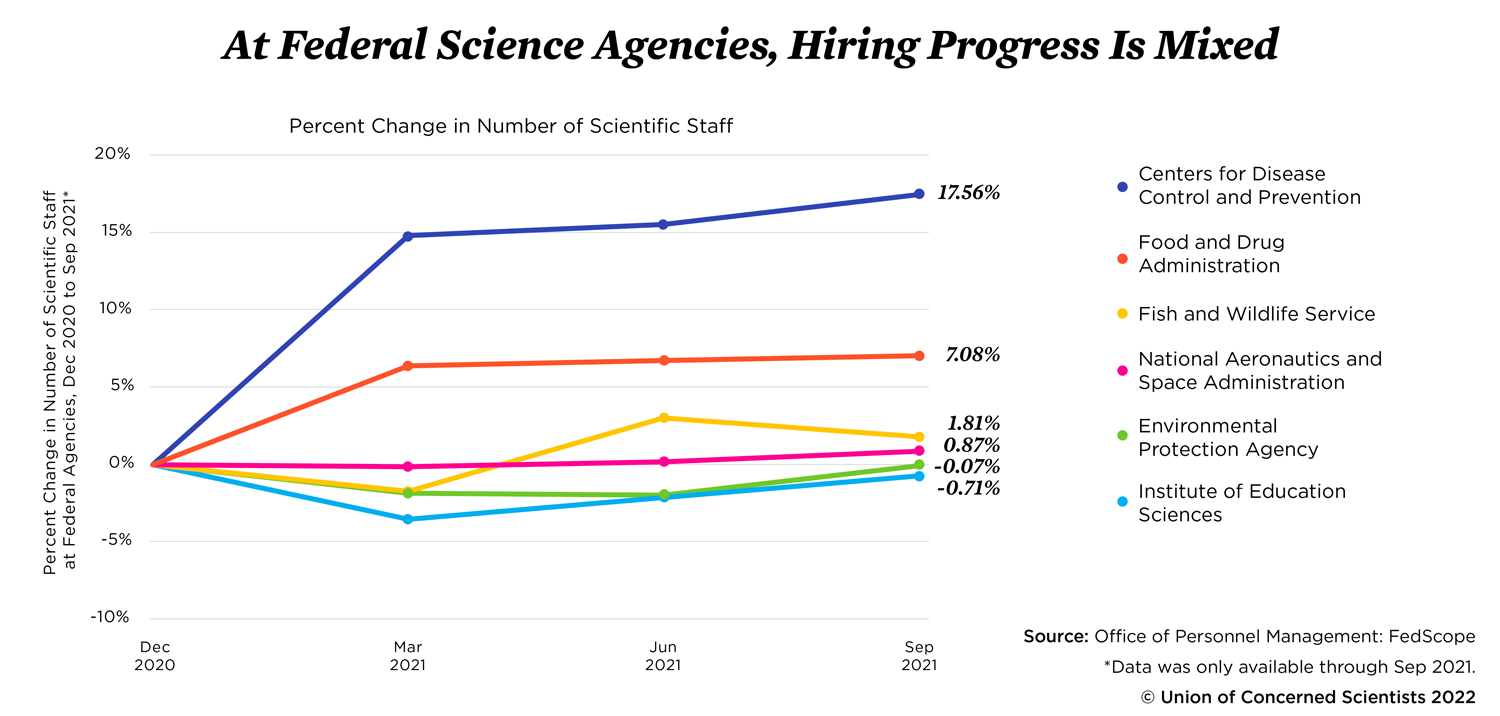
Share this graphic on Twitter | Share this graphic on Facebook
As we face mounting crises, including the COVID-19 pandemic and the worsening impacts of climate change, the United States needs scientists who serve the public good. The previous administration undermined these scientists and many left the civil service entirely. Since then, the Biden-Harris administration has worked to build up the federal scientific workforce, but progress is mixed across different federal agencies.
Read More: Biden's Actions on the Federal Scientific Workforce
Cracks have formed in the foundations of government science. Between 2017 and 2020 in particular, political officials stunted or stalled research, emptied scientific offices, and undermined career staff. Some offices, battered by political attacks, hemorrhaged experts.
Last fall, the Union of Concerned Scientists (UCS) analyzed years of staffing data from federal agencies. We found that, between 2016 and 2022, five federal agencies alone lost more than 1,000 scientists collectively. This confirmed results from our 2018 survey of federal scientists, the majority of whom reported seeing workforce reductions.
This erosion matters. Anemic agencies, bled of their brainpower, cannot do their work. For example, in 2019, the Trump administration abruptly moved the two research agencies of the US Department of Agriculture from Washington, DC, to Missouri. Three in four staff were forced to resign or retire, taking with them years of institutional knowledge. Economic reports slowed to a trickle. Years-long studies crumbled. And millions of dollars in funding for research—on climate change, food security, and antibiotic resistance—sat unreleased.
Restoring the Scientific Workforce: White House Actions
The Biden-Harris administration has signaled its intent to revitalize the federal workforce, and so far, it has taken promising steps. In June 2021, President Biden signed an executive orderdirecting agencies to promote diversity, equity, and inclusion in their workforces. But hiring is one thing; keeping employees is another entirely. To create a culture that supports scientific staff, the White House has already worked to strengthen protections for federal science—new ethics requirements, stronger scientific integrity policies, and investigations into past assaults on science and how to prevent them in the future.
Beyond the White House, many federal science agencies—eager to attract new talent—have announced thousands of job openings. But while some agencies have seen success, others are struggling.
The CDC Employs More Scientists Today than Ever Before
The Centers for Disease Control and Prevention (CDC), a federal agency dedicated to protecting public health, provides scientific expertise and guidance during crises like the COVID-19 pandemic. But the agency has humble origins: it was founded in 1946 and began with fewer than 400 employees. For the most part, the number of public health scientists at the CDC has grown since the agency was founded—with some exceptions, most notably between 2004 and 2008, when it lost hundreds of employees.
So far, the Biden-Harris administration has continued these trends: under President Biden, the number of CDC scientists has grown by about 18 percent since December 2020, reaching a record high of 8,629 scientists employed as of June 2021. This means that scientists make up most of the agency's total staff (11,628 employees).
The FDA Hires More Scientists, Too
The Food and Drug Administration (FDA) also plays an enormous role in safeguarding public health. The agency uses science to make decisions about the safety and efficacy of drugs and medical therapies—including those that protect the US public against COVID-19, like vaccines and antiviral drugs.
As of September 2021, the agency employed 19,653 staff, of whom 15,112 are scientists. Under the Biden-Harris administration, the FDA hired roughly 1,000 new scientists, representing a nearly 7 percent increase in its scientific workforce.
The EPA Is Struggling to Replace Expertise Lost under the Previous Administration
The Environmental Protection Agency (EPA) uses science to protect human health and the environment from many dangers, including toxic chemical exposure, heat-trapping emissions, and dirty air and water. The agency was founded in 1970, when its staff numbered a little over 4,000. Since then, the EPA has grown, and in 1999, it hit a record high of more than 18,000 employees. Generally, scientists make up roughly 70 percent of the agency's staff.
But according to an analysis UCS published in January 2021, the EPA lost more than 1,000 scientists under the prior administration. In 2018, the agency saw its lowest number of total staff members in more than 30 years.
While the Biden-Harris administration has pledged to fill this staffing gap, and the agency's current administrator, Michael Regan, has promised to hire more staff and bring science back to the agency, data show that, as of September 2021, the EPA has a lot more work to do: as of September 2021, the EPA reached staffing levels observed in December 2020.
At Other Agencies, Hiring Progress Is Mixed
While public health agencies, like the CDC and FDA, have seen increases in scientific staff during the first six months of the Biden-Harris administration, hiring at other science-based agencies has lagged. For example, the research branch of the Department of Education, the Institute of Education Sciences, lost over 19 percent of its scientific staff under the previous administration—and from December 2020 to September 2021, it saw another 1 percent drop. The Fish and Wildlife Service—which lost231 scientists under the previous administration—had gained 181 scientists by June 2021, a good start but not enough. Scientific staffing at other agencies, like the National Aeronautics and Space Administration, has held relatively steady during the first six months of the Biden-Harris administration and well before.
Building a Strong, Diverse Scientific Workforce
The previous administration left enormous holes in the government's capacity to conduct science, a task that requires a lot of qualified experts. While the Biden-Harris administration has committed to leading with evidence and restoring science to its rightful role in government, it may take more than a year to see if these efforts bear fruit.
So far, the administration's record is mixed. President Biden's team should strive to hire more scientific experts at federal agencies, recruit a more diverse workforce, and expand opportunities for early career and midcareer scientists to join their ranks. If you are a scientist interested in becoming a public servant, this toolkit from the Center for Science and Democracy at UCS can help you navigate this process.
This section was authored by Jacob Carter, the research director of UCS's Center for Science and Democracy.
Scientific Integrity
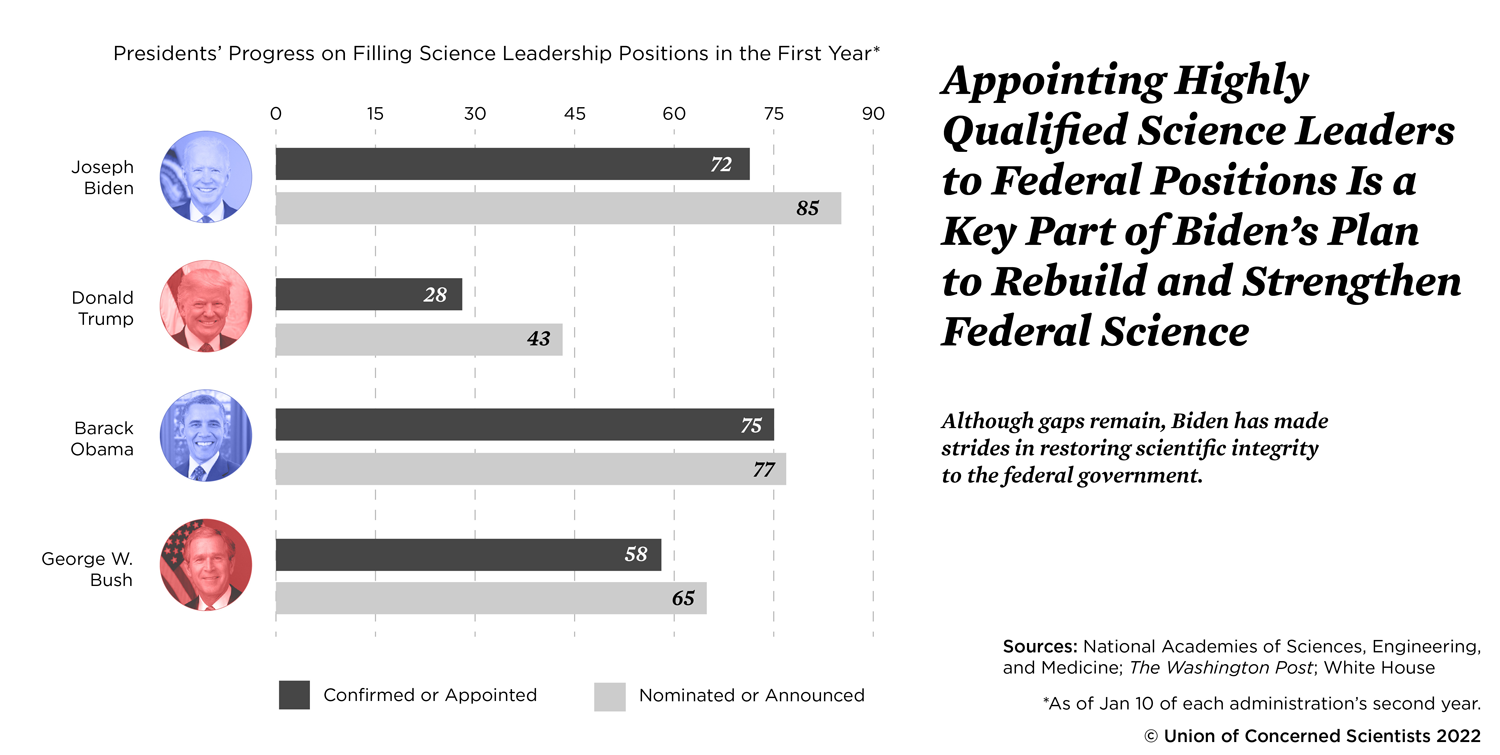
Share this graphic on Twitter | Share this graphic on Facebook
Since his first day in office, President Biden has taken action on scientific integrity. His administration has filled some leadership positions with qualified experts, kick-started efforts to strengthen protections for federal scientists, and reversed many damaging anti-science actions undertaken by the previous administration. But restoring federal science (and the public’s trust in it) will take years, and the administration must do more to make government science transparent and independent, not merely for the duration of his presidency, but for decades to come.
Read More: Biden's Actions on Scientific Integrity
We cannot take robust government science for granted. Without strong policies to protect federal science, the decisions we rely on—for clean water, breathable air, a livable climate, and healthier communities—can fall victim to political attack.
Many federal agencies have created policies to promote scientific integrity—that is, the proper use of independent science in decisionmaking. But even when policies are strongly written, their implementation and enforcement may be insufficient. These gaps can lead to political efforts to undermine science, an outcome amply illustrated by the more than 200 Trump-era attacks on science documented by the Union of Concerned Scientists (UCS).
Fortunately, President Biden has already bulked up protections for federal science. Almost immediately, he wisely revoked a Trump executive order that had required agencies to purge two rules for every new one created. Then, on January 27, 2021, President Biden signed a historic memorandum outlining a bold vision for the future of science in government. The memo directed agencies to assess their scientific integrity policies—what is working and what is not, the extent to which policies are enforced, and how protections might be strengthened.
The memo also created a White House task force to review incidents of "improper political interference" in the recent past. In July 2021, the task force solicited feedback from the public, requesting public comments and hosting virtual listening sessions, to inform a comprehensive report on federal scientific integrity. Since then, however, updates on the task force's report have been sparse. On January 11, 2022, the task force released its long-awaited report. Although the report summarized scientific integrity issues and offered some recommendations for remedying them, it lacked details—for example, on accountability measures, including consequences for violations of scientific integrity policy; the incorporation of diversity, equity, inclusion, and accessibility into policies; and even what the task force's next steps are.
Bringing in the Scientists and Letting Them Lead
Federal scientists have mapped the human genome, created the World Wide Web, and shaped revolutionary treatments for disease. And these scientists work daily to protect our food supply, study climate change, prepare the public for storms and disasters, and reduce pollution risks. But during the previous administration, thousands of these experts left civil service.
The Biden-Harris administration has already taken steps to undo this damage. Days after his inauguration, President Biden revoked one of Trump's last-minute executive orders, which would have made it easier to fire federal employees for political reasons. A week later, President Biden signed a memo requiring every science agency to have a chief science officer and a scientific integrity official. He also took the unprecedented step of elevating his science adviser to the cabinet level, a move UCS has recommended for more than a decade.
President Biden has begun asking scientists to lead, too. He has announced nominations for 85 of the roughly 100 high-level science positions selected by the president; 72 of these nominations have been finalized (including some requiring confirmation by the Senate). This represents a fast pace, compared to the prior administration: Trump announced only 43 nominations and had only 28 finalized by the end of his first year in office (and many had enormous conflicts of interest or lacked qualifications). President Biden has now narrowly exceeded even the pace of the Obama administration's first-year nominations.
Letting Experts Advise
To create effective policies, the federal government relies on scientific advice, a need filled in large part by experts who sit on more than 200 scientific advisory committees. During the previous administration, however, political officials disbanded some of these committees and installed unqualified members and members with conflicts of interest in some that remained.
The Biden-Harris administration has begun undoing this damage. On his first day, President Biden revoked a Trump rule that had required agencies to slash a third of all advisory committees, and a week later, he directed agencies to assess how to protect these committees. Some agencies were proactive: in March 2021, the EPA "reset" two committees by emptying their rosters and starting anew within months, filling their ranks with qualified experts from diverse backgrounds.
Now, the administration needs to continue this work, making the nation's science advisory committees more resilient and more reflective of the public they serve. Committee membership must be more diverse throughout the federal government, agencies must rigorously guard against empaneling members with conflicts of interest, and the government must do all it can to inform the public about the purpose and people serving in these advisory roles.
Keeping Out Conflicts of Interest
On his final day in the White House, President Trump released his aides from ethics requirements that were intended to endure years after they departed from government. This move freed them to take advantage of lucrative lobbying jobs.
That same day, President Biden affirmed his administration's commitment to ethics, restoring the requirements for his incoming staff that President Trump had undone for his aides. But President Biden must do more. His ethics pledge prevents his staff from working as lobbyists for two years after they leave government, but the restrictions ought to last even longer. President Biden also ought to ensure that officials' conflicts-of-interest waivers—documents that outline officials' conflicts of interest and, in many cases, bar officials from working on related activities—are routinely_ _made public.
Involving the Public
Because our leaders are elected by and for the people, the public should know what goes on in its government. Unfortunately, this kind of transparency was a rarity during the previous administration, which hid visitor logs, spurned congressional oversight, rained hostility on the free press, and rammed through regulations with scant public input.
So far, the Biden-Harris administration has done far better. President Biden has already tasked agencies with improving public access to federal data. When appointees are exempted from certain ethics requirements, their names must be made public, and the administration has asked agencies to make the regulatory process more inviting to the public (although the details have yet to be worked out).
But while the White House plans to release some of its visitor logs, it will not release virtual visitor logs—a big problem, especially during a pandemic that has kept many events online. President Biden has also done little to reform the Freedom of Information Act, a law that is supposed to give the public access to government records but, in practice, is plagued with problems and abused by agencies. The White House cannot change this on its own: Congress must step up.
Here at UCS, We Are Keeping Watch
This is not an exhaustive list of successes or roadblocks on scientific integrity and transparency in public policy. The administration has made significant progress and yet must still do more to protect scientists and their role in decisionmaking. In the months to come, we will continue to track the administration's actions, celebrating progress and, when needed, demanding more.
This section was authored by Taryn MacKinney, the investigative researcher for UCS's Center for Science and Democracy.
Climate Change
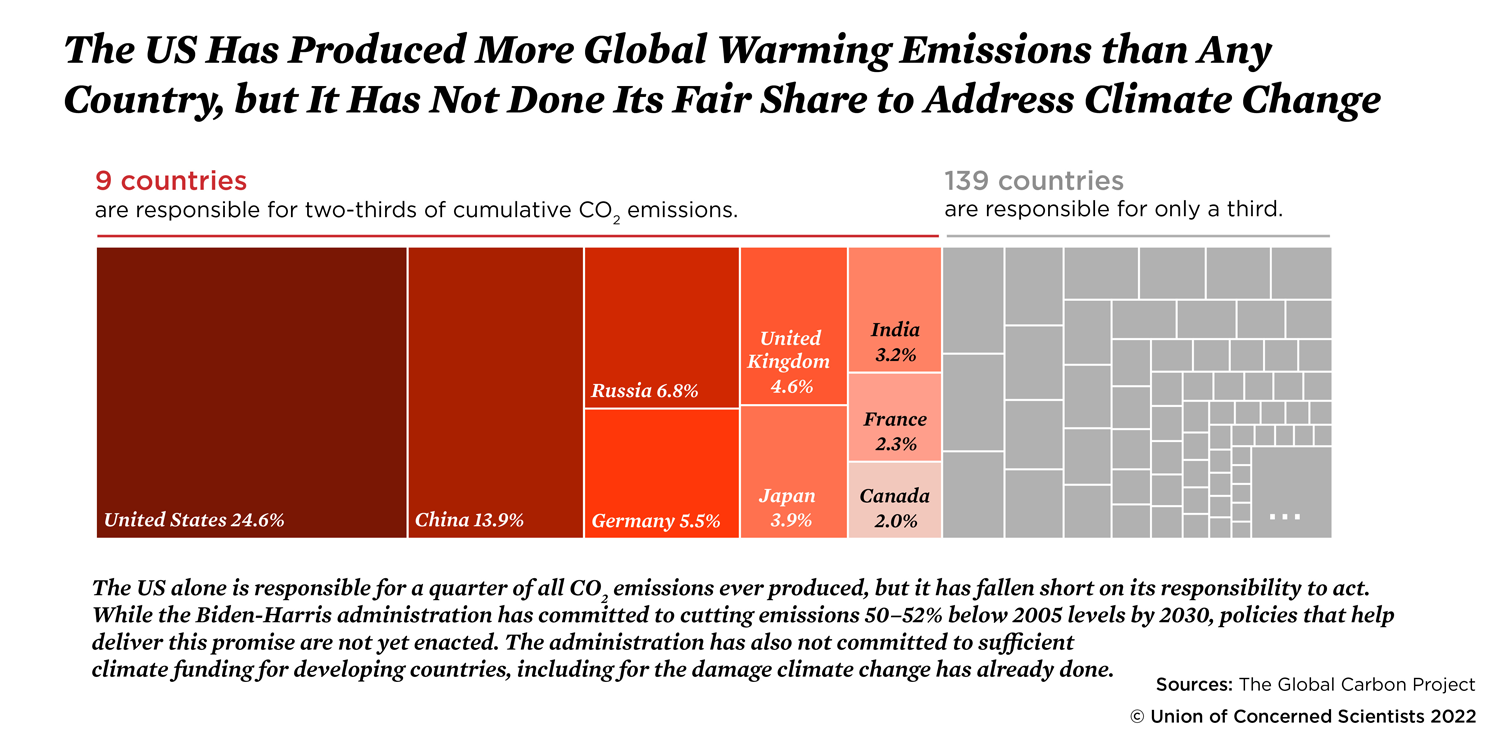
Share this graphic on Twitter | Share this graphic on Facebook
In its first year, the Biden-Harris administration has begun pursuing an ambitious climate and clean energy agenda: rejoining the Paris climate agreement, pledging to reduce heat-trapping emissions, and launching efforts to build climate resilience by giving communities tools and funding to prepare for climate impacts. However, with the growing urgency of the climate crisis, the administration must do more to follow its plans with concrete, robust, and durable policies. Otherwise, the United States will fall short on its goals of sharply curbing heat-trapping emissions within this decade, protecting communities from the worst impacts of climate change, and upholding the nation's responsibilities to the world.
Read More: Biden's Actions on Climate Change
A Whole-of-Government Approach to Tackling Climate Change
The science is clear: climate change is here, and the longer we wait to act, the worse its impacts will be. Communities across the United States and the world are already facing climate-driven heatwaves, floods, droughts, and wildfires, and these harms are disproportionately borne by Black, Brown, and Indigenous people. Meanwhile, a transition to clean energy would greatly benefit public health and the economy. The federal government has a grave responsibility to follow the science and tackle this crisis.
So far, the Biden-Harris administration's plans show it takes these challenges seriously. On his first day in office, President Biden reentered the United States into the Paris Agreement, the international climate accord that the Trump administration had spurned. Soon after, President Biden signed a sweeping executive order on climate change, establishing the White House Office of Domestic Climate Policy and elevating the position of special presidential envoy for climate to the National Security Council. The order also created the White House Environmental Justice Advisory Council, an advisory body of experts who will help the government embed environmental justice in its work on climate change and beyond.
The administration has directed federal agencies to reduce carbon pollution, help communities become more climate resilient, advance environmental justice (e.g., through the Justice40 initiative), and ensure that the nation's clean energy transition creates good-paying, high-quality jobs. The administration has also emphasized the importance of a fair transition for fossil fuel–dependent workers and communities and established a clearing house for aid opportunities, but so far, specific new policies have been lacking. Biden's team is also asking Congressto better fund climate science across agencies—a vital move, especially after the last administration's efforts to hollow out federal science.
Cutting Heat-Trapping Emissions: Bold Targets, Missing Policy Details
In April 2021, the administration made a bold promise: by 2030, the United States would cut its heat-trapping emissions 50 to 52 percent below 2005 levels. To kick-start this, the administration proposed an expansive plan for investing in low-carbon infrastructure, cutting emissions across the economy, and building climate resilience, while advancing environmental justice and creating good-paying, high-quality jobs. Some elements of the plan have been signed into law, but the primary climate components remain outstanding in the stalled Build Back Better Act.
Agencies are also working to advance the administration's climate agenda. Announced and forthcoming proposals from the Environmental Protection Agency will help limit methane emissions from the oil and gas sector, cut carbon pollution from vehicles and power plants, and phase down hydrofluorocarbons, potent heat-trapping gases used in refrigerators and air conditioners.
The Department of Energy launched the Energy Earthshots Initiative, a program to accelerate breakthroughs in clean energy. And to meet the administration's goal of deploying 30 gigawatts of offshore wind energy by 2030—which would generate electricity to power over 10 million US homes—the Department of the Interior recently announced plans for offshore wind leases and approved the first large-scale commercial projects in federal waters. Another executive order commits the federal government to procuring 100 percent carbon-free electricity by 2030 and acquiring 100 percent zero-emission vehicles by 2035. And to involve the public in its work, the Federal Energy Regulatory Commission created a new Office of Public Participation.
Elsewhere, however, the administration's record is mixed: it has restarted new oil and gas lease sales after a temporary moratorium and continued to grant new permits for oil and gas extraction on federal lands and to support new fossil fuel infrastructure.
Climate Resilience: A Foundation Laid, but No National Strategy
Even as we work to sharply cut emissions, we must also advance climate resilience—communities' ability to prepare for, adapt to, and recover from the impacts of climate change. Current disaster response policies are inadequate and often reinforce existing socioeconomic inequities.
The administration has made strides in advancing climate resilience. It has directed agencies to create climate adaptation plans, reinstated the federal flood risk management standard to protect federally funded infrastructure, and sought more resources for federal programs aimed at reducing risks from climate impacts, like flooding and wildfires. To better protect workers from dangerous heat, the administration has directed the Department of Labor to prepare a heat safety standard.
The administration has also taken steps to address inequities in disaster response, but there is a long way to go. For example, the Federal Emergency Management Agency updated its guidance for accessing post-disaster aid, to help undo long-standing economic and racial inequities (historically, after major disasters, wealthier White households have been shown to receive more aid than lower-income Black families). The administration also launched the President's Emergency Plan for Adaptation and Resilience, an initiative that intends to help climate-vulnerable developing countries. Meanwhile, the Department of Housing and Urban Development is reforming its Community Development Block Grant program, a major source of investments in safe, affordable homes that are vital for underserved communities.
These are enormous efforts, but many—perhaps most—are only plans so far. The administration must do more to advance a proactive national climate resilience strategy that connects the local to the national and is informed by science and community engagement.
Economic Risks of Climate Change
Climate change poses enormous financial and economic risks: extreme temperatures harm workers' health and productivity, coastal real estate is vulnerable to rising seas, and extreme weather threatens farmers' livelihoods and businesses' supply chains.
To address these challenges, the government must ensure that awareness of these risks guides public, policy, and marketplace decisions. Here, the administration has made some progress. The White House is updating the social cost of greenhouse gases, and the Department of the Treasury is taking action to better ensure that climate risks inform market decisions. These efforts—coupled with actions by independent regulators like the Federal Reserve and the Securities and Exchange Commission—can force companies to disclose the climate risks of their actions and push investments away from fossil energy and toward resilient, clean options. The administration must also ensure that these measures do not exacerbate existing socioeconomic and racial inequities, such as through forced displacement or gentrification.
Global Commitments: A Good Start, but Still Falling Short
Under President Biden, the United States has stepped back into the global arena to fight climate change, but its concrete actions still fall short, particularly given that the United States is the largest historical contributor to global heat-trapping emissions.
The administration made a bold emissions-reduction commitment and helped launch the Global Methane Pledge, aimed at cutting global methane emissions 30 percent below 2020 levels by 2030, which is now supported by more than 100 countries. It has also asked the Senate to ratify the Kigali Amendment to the Montreal Protocol, a global pact to phase down hydrofluorocarbons. At the Glasgow climate talks in November 2021 (COP26), the administration pledged to help halt deforestation and stop financing unabated fossil energy projects overseas.
However, richer nations, including the United States, have failed to deliver on a long-standing pledge to marshal $100 billion a year by 2020 for developing countries—and accelerating climate change has driven up needs acutely. The United States has promised to provide $11.4 billion per year by 2024 to help developing nations cut their emissions and adapt to climate change, and it made its first-ever contribution of $50 million to the United Nation's Adaptation Fund. But these commitments are not guaranteed: Congress must approve this funding. Overall, the nation's commitments on climate finance have fallen short, especially funding for the damage that climate change has already done: at COP26, the United States and other rich countries blocked a proposal for a "loss and damage" fund.
The Path Forward
In this decisive decade for climate action, the Biden-Harris administration's climate agenda must be actionable and guided by the latest science, not merely aspirational. It must serve the people, not the fossil fuel industry. To deliver on its commitments, the administration must take on entrenched interests, push for systemic change, and close the gap between intention and action.
Congress, too, must step up and do its part. Fossil fuel companies will also need to be held accountable for climate damages and fraud through the courts. Current and future generations and the planet depend on what we do today; promises are not enough.
This section was authored by Rachel Cleetus, the policy director of UCS's Climate and Energy Program.
COVID-19 Response
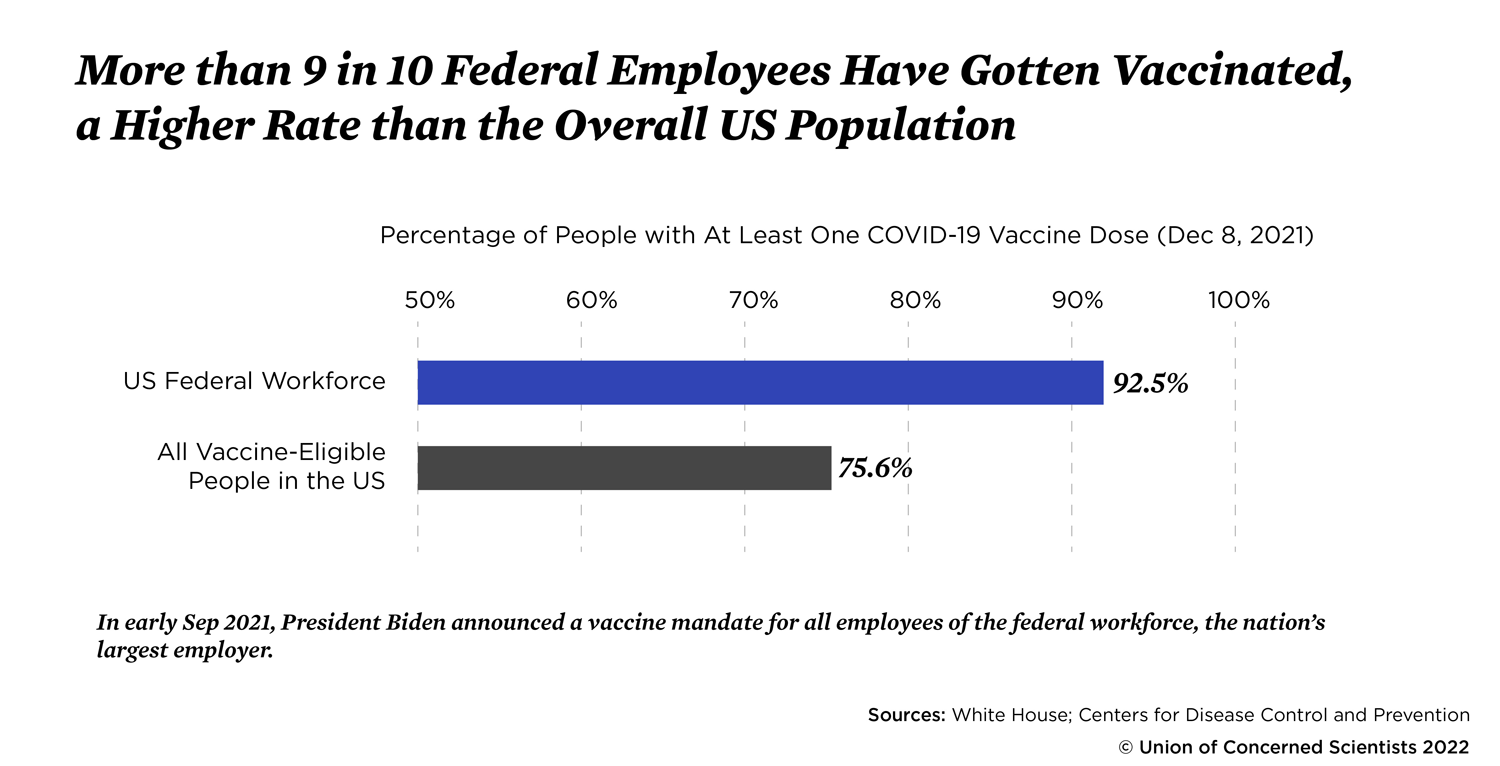
Share this graphic on Twitter | Share this graphic on Facebook
The COVID-19 pandemic has dominated US life for nearly two years, but the two presidents tasked with managing the crisis have taken starkly different paths. President Biden's predecessor largely denied the pandemic, hushing scientists and doing little to stop COVID-19's path of destruction. President Biden, on the other hand, has risen to the challenge, listening (for the most part) to the scientists and championing public health measures like vaccinations and mask use—even in the face of political resistance and an ever-evolving virus, both of which remain obstacles for the administration.
Read More: Biden's Actions on COVID-19
Since the emergence of the novel coronavirus, the COVID-19 pandemic has raged for nearly two years, killing more than 800,000 people in the United States and close to 5.5 million people globally, with undoubtedly many more unattributed deaths resulting from the virus.
For the most part, President Biden's predecessor displayed an unfathomable disregard for the realities of the pandemic. In February 2020, President Trump claimed the pandemic would taper off in April (it did not); in June, he said it was "fading away" (it was not). He falsely blamed the Obama administration for passing on a "broken" test for the virus; floated the idea that bleach, if injected, might protect against infection; and curbed opportunities for public health experts to speak to the public.
When President Biden took the helm in January 2021, he promised to do things differently and, despite some missteps, the administration's response to the pandemic has been based on science and well executed.
The Administration Is Acting Quickly on COVID-19
In its first week, the Biden-Harris administration proposed ways to improve vaccine distribution; announced that masks would be required on federal property; established a White House position to coordinate the federal response to the COVID-19 pandemic; issued an order to increase COVID-19 data collection efforts across the federal government; and ordered agencies to inventory pandemic-related supplies, such as personal protective equipment. The administration also declared that it would prioritize the issue of racial equity—a necessity, given that COVID-19 has infected, hospitalized, and killed disproportionately more people of color than White people.
President Biden has also deferred to the experts, another marked departure from his predecessor. For example, Biden's White House reinstated regular press briefings on COVID-19, led by Drs. Anthony Fauci, Rochelle Walensky, and Vivek Murthy—all qualified experts and dedicated public servants.
On some issues, however, the administration's actions have raised eyebrows. In May 2021, the CDC announced that vaccinated people could forego masks in public, a virtually unenforceable policy that could worsen infections, especially in communities wary of vaccines (although this policy was reversed when the Delta variant swept the nation). And although the administration has laudably relied on the expertise of health officials in decisionmaking, it has sometimes bypassed their guidance. For example, in mid-August 2021, President Biden announced—before the Federal Drug Administration did—that booster shots would be made available to the public.
For the most part, however, the administration has navigated the perilous second year of the pandemic with strong leadership and a commitment to science.
Resistance to Vaccines Runs Deep
Despite the administration's efforts to tame the pandemic, resistance to public health measures runs deep among certain groups in the US, blunting the White House's ability to control the crisis. As of early December, nearly a year after vaccines were approved for public use, only 75.6% percent of vaccine-eligible people have received at least one vaccine dose.
Although resistance to COVID-19 vaccines has declined, holdouts exist, and partisanship appears to be a big factor: of US adults who still hadn't been vaccinated by October 2021, six in ten were or leaned Republican—and only one in six was or leaned Democrat. Meanwhile, misinformation reigns, dissuading many from receiving doses of the extremely safe vaccines. The administration has struggled to focus its efforts on combatting this misinformation, despite enormous investments in public education campaigns aimed at persuading those still hesitant.
The Federal Government Shows That Vaccine Mandates Work
Especially since the summer, more US employers have begun requiring vaccinations for their employees. These mandates are extremely effective. After the Mohawk Valley Health System in New York instituted a vaccine mandate, the percentage of its employees who were vaccinated against COVID-19 rose from 70 percent over the summer to nearly 96 percent. The vaccination rate of Kaiser Permanente employees rose from 78 percent to 97 percent after its mandate took effect, and Tyson Foods—despite its complicity in COVID-19 infections and deaths of its meatpacking workers, especially early in the pandemic—saw astonishing success with its mandate, bumping its vaccination rate from 50 percent to 96 percent.
These successes did not go unnoticed by the new administration. This fall, President Biden announced that employers with 100 or more employees must either require coronavirus vaccinations for their workers by January 2022 or require that workers be tested weekly. But only days after the administration released details on the plan, a federal court halted the mandate's rollout until legal challenges could be heard in court. With COVID-19 cases once again on the rise and the new Omicron variant sweeping across the world, the court's decision could have ruinous consequences for public health.
Meanwhile, the administration's efforts to increase vaccinations have fared better among federal employees. In early September 2021, President Biden announced a vaccine mandate for all employees of the federal workforce, the nation's largest employer. The mandate's success has been impressive and swift. In December 2021, the administration revealed that 92.5 percent of the federal workforce had received at least one vaccine dose, and more than 97 percent had complied with the mandate (including those who received exemptions or extensions).
The Obstacles Ahead
With vaccine mandates tied up in courts, millions of people refusing safe and free vaccinations, and COVID-19 still hitting Black, Brown, Indigenous, immigrant, and low-income communities hardest, the pandemic rages on. Still, the administration has dedicated enormous effort to combatting this tragic crisis and must not give up now: in the coming months, the administration must continue to defend and expand vaccine and masking mandates, fight COVID-19 misinformation in all its forms, and do all it can to protect those most vulnerable to this devastating disease—including expanding its efforts to advance global vaccine equity.
President Biden's team must also look to the future. The COVID-19 crisis was not the first global pandemic, and it will not be the last, but the United States and the world remain ill-equipped to handle future global disease outbreaks. If we are to safeguard the public for the next pandemic, we must act now—and if we do not, we imperil ourselves and the generations to come.
This section was authored by Taryn MacKinney, the investigative researcher for UCS's Center for Science and Democracy.
Nuclear Weapons
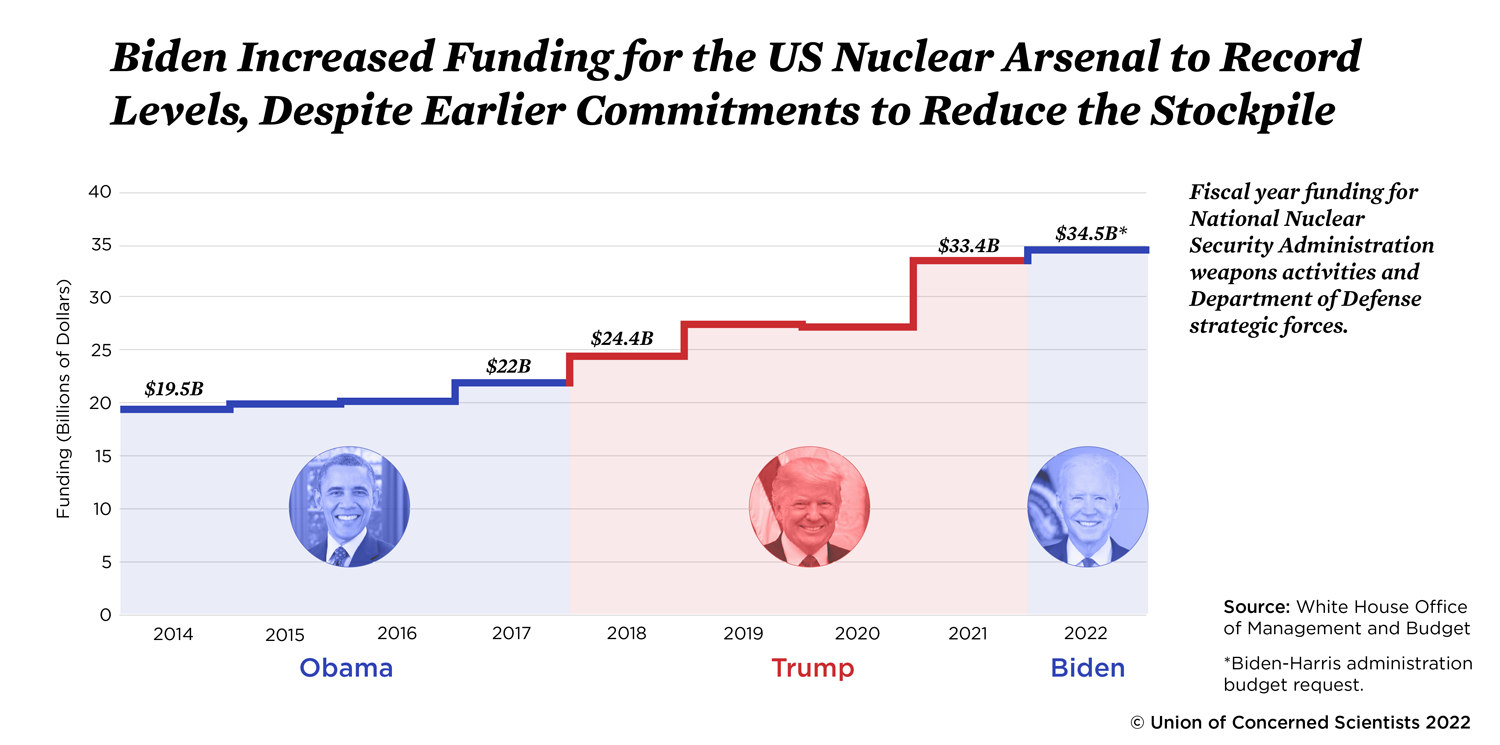
Share this graphic on Twitter | Share this graphic on Facebook
On the campaign trail and during his first year in office, President Biden repeatedly expressed the need to set a new policy agenda for nuclear weapons—one that minimizes the risk that these weapons could be used in a conflict. Biden criticized his predecessor's decision to pursue new nuclear weapons programs, arguing that new warheads make nuclear war more likely. While the Biden-Harris administration has made progress on some key arms control initiatives, it has done little to distinguish its nuclear agenda from that of the previous administration, particularly when it comes to the enormous and growing costs of US nuclear weapons programs.
Read More: Biden's Actions on Nuclear Weapons
Nuclear Weapons: Some Progress, More Problems
On the campaign trail, President Biden consistently pledged to restore US leadership on arms control and nonproliferation efforts around the world, and he began by quickly extending the New START arms control agreement. Negotiated under the Obama administration, this treaty between the United States and Russia set limits on the two countries' nuclear arsenals, curbing a costly and dangerous arms race. Within two weeks of Biden's inauguration, the administration reached an agreement with Russia to extend the treaty for another five years.
The Biden-Harris administration has also opened channels of communication between the United States and potential adversaries, to manage tensions, reduce the risk of nuclear conflict, and cooperate on arms control.
- During a June 2021 summit, President Biden and Russian president Vladimir Putin agreed to initiate a series of discussions on nuclear weapons–related issues between the two countries. The leaders also issued a joint statement reaffirming the principle, first expressed by former US and Russian presidents Ronald Reagan and Mikhail Gorbachev, that "a nuclear war cannot be won and must never be fought."
- In November 2021, President Biden raised the possibility of similar talks with Chinese president Xi Jinping, but no agreement was reached.
Elsewhere, things have not gone as well. Consider the Iran nuclear deal. The administration declared one of its top foreign policy goals was to restore the deal, a historic agreement—also negotiated under the Obama administration—that placed strict limits on Iran's nuclear program in exchange for relief from international sanctions. But in 2018, President Trump withdrew the United States from the deal and slapped Iran with harsh sanctions, leaving US allies scrambling to salvage the agreement. So far in 2021, the Biden-Harris administration has maintained those sanctions and been slow to engage Iran, despite the urgent need for a renegotiated nuclear deal. Iran has already restored much of its capacity to enrich uranium, a key ingredient in nuclear weapons, and negotiations between the United States, Iran, and other parties to the deal are going poorly.
In 2017, Biden said, "If future budgets reverse the choices we have made—and pour additional money into a nuclear buildup that harkens back to the Cold War—it will do nothing to increase the day-to-day security of the United States and our allies." Yet the White House's first budget request did nothing to scale down the nuclear spending of the previous administration. The nation is on track to spend more than $1 trillion on its nuclear arsenal over the next thirty years. In 2020, the Trump administration proposed a record budget for nuclear weapons, only to have the Biden team request even more money this year, and the budget seeks funds for programs that Biden himself condemned on the campaign trail.
- For Fiscal Year 2022 (FY22), the Biden-Harris administration requested $34.5 billion in funding for the nuclear arsenal, a 3 percent increase from the Trump administration's budget request and a 77 percent increase from that of the Obama administration.
- The administration's FY22 budget request included $10 million for a new sea-launched, nuclear-armed cruise missile. The Obama administration had eliminated a previous version of this weapon, but the Trump administration began a program to build a new one. During his campaign, Biden called this weapon a "bad idea" that would make the United States "more inclined" to use nuclear weapons. Now his administration seeks to fund it.
- The administration's FY22 budget request also included $99 billion for the B83 warhead, more than the Trump administration had projected would be necessary for the weapon. The B83, roughly 80 times more powerful than the bomb dropped on Hiroshima, is the most destructive nuclear warhead in the US arsenal. The Obama administration planned to retire the B83, but the Trump administration reversed that decision, and the Biden team seems to have doubled down on that path.
Will Biden Set a New Nuclear Agenda, or Fall Short?
President Biden's most important opportunity to revamp the nation's approach to nuclear weapons is during the Nuclear Posture Review (NPR), which his administration is currently conducting. This comprehensive assessment will lay out the administration's views on nuclear weapons policy and answer key questions, including what role nuclear weapons ought to play in US strategy and how nuclear forces should be adjusted to reflect that role. Perhaps the administration's NPR could end up reflecting Biden's stated nuclear agenda—fewer weapons, less reliance for nukes—better than his administration's budget did. However, early signs are troubling. In September 2021, the Pentagon ousted a key administration official involved in drafting the NPR, reportedly for exploring options that President Biden had previously supported publicly.
So, while the administration has taken steps toward its foreign policy goals on arms control, it has done nothing to meet President Biden's stated aim of reducing the role that nuclear weapons play in US national security. To reduce the risk of nuclear war, the administration must coordinate closely with its allies and adversaries abroad—but President Biden will also have to wade into, and challenge, the Pentagon's bureaucracy and entrenched military-industrial complex. If he does not, we will remain trapped in an unnecessarily dangerous world.
This section was authored by Jennifer Knox, the policy and research analyst for UCS's Global Security Program.
Protecting Democracy

Share this graphic on Twitter | Share this graphic on Facebook
A healthy democracy is necessary to ensure that science works in the public interest, from public health initiatives to evidence-based policies. Over the past few years, many right-wing organizations and elected Republican leaders have attacked voting rights, cast doubt on free and fair elections, and served private or partisan interests over the public good. The Biden-Harris administration has stated that voting rights are a priority, but it must do far more to pull US democracy back from the brink, including active support for reforming or abolishing the Senate filibuster.
Read More: Biden's Actions on Protecting Democracy
Over the past year, the Biden-Harris administration has faced enormous challenges, from battling the COVID-19 pandemic to stemming the tide of climate change—global crises that require global solutions. But one of the crises the new administration faces is happening only here: US democracy, as we know it, is in peril.
US Democracy under Siege
Across the country, legislators are cracking down on voting access—slashing early voting, purging voter rolls, and closing polling sites. During the 2021 legislative session, lawmakers in 48 states introduced nearly 400 bills to restrict voting, according to the nonpartisan Brennan Center for Justice, and by early October 2021, 19 states had enacted 33 new laws that curtail voting access. These restrictions are targeted efforts to keep specific groups of people away from the ballot box: Black people, Indigenous people, young people, and other voters of color. Worse yet, legislatures are drawing "gerrymandered" districts to reduce representation of Black people, Indigenous people, and communities of color.
Biden's Team Is Taking Some Action on Voting Rights
So far, the administration has recognized the gravity of this crisis. President Biden and Vice President Harris have given dozens of speeches and attended meetings with voting rights advocates and organizations, as well as civil society and good-governance groups. However, up until January 2022, the White House had only held one event dedicated solely to voting rights (the second one was a joint address in Georgia in January)—in contrast with other priorities for the administration, which has held more than 60 events on the COVID-19 pandemic and nearly 40 on the Build Back Better Act and the bipartisan infrastructure bill.
Still, there has been progress, though often slow. In March 2021, less than two months after his inauguration, President Biden issued a sweeping executive order on promoting access to voting, which:
- directed federal agencies to expand access to voter registration and election information;
- directed federal agencies to assist states under the National Voter Registration Act;
- asked agencies to improve and modernize Vote.gov, a federal website that provides information on how, where, and when to vote;
- increased federal employees' access to voting;
- set aside funding to analyze barriers to voting for people with disabilities;
- established steps to increase voting access for active-duty military and other overseas voters;
- provided voting access and education to citizens in federal custody; and
- established a Native American voting rights steering group to help guide the federal government on its work to expand voting access for Indigenous communities.
Following the tone set by the White House, Attorney General Merrick Garland announced in June 2021 that the Department of Justice would double the enforcement staff of the civil rights unit at the department—even going a step further to set up a criminal task force to crack down on intimidation of election employees, which continues to be a problem in communities across the country.
The Filibuster Is Obstructing Reform
Executive-branch action on voting rights has its limits: Congress must pass vital reforms into law. But Republican lawmakers—breaking from the tradition of previous Congresses—have not been honest brokers on the issue of voting rights. They have used the Senate filibuster, a procedural step that gives the minority party undue, outsize power, to obstruct debate on voting rights bills that would protect the right to vote for all of the US public, including the Freedom to Vote Act and the John Lewis Voting Rights Advancement Act.
With the 2022 midterm elections around the corner, the specter of the 2024 presidential election looming, and state legislatures scrambling to redraw their district boundaries, the White House must use its bully pulpit to secure a win on voting rights. The bills mentioned above are a necessary start, and the administration must publicly declare its support of eliminating the Senate filibuster or, at a minimum, amending the filibuster rules to create a carve-out for voting rights.
The administration has made no definitive statements concerning the filibuster. However, President Biden and Vice President Harris have thrown their support behind a suite of bold and transformative legislation, which would expand voting access, improve fair representation, and save US democracy:
- Freedom to Vote Act (S. 2747): This transformational legislation, which stems from the For the People Act (H.R. 1), would create national standards for elections and voting processes. The bill would also protect the freedom to vote, get big money out of politics, combat partisan election subversion, and help ensure that congressional districts are drawn to give fair representation to all.
- John Lewis Voting Rights Advancement Act (H.R. 4|S. 4): This bill restores key provisions from the Voting Rights Act of 1965, a historic law that the Supreme Court gutted in 2013. Following that Supreme Court decision, several states passed sweeping voter suppression laws. By restoring the law, the federal government will have the necessary tools needed to address discriminatory voting practices—usually practices that disproportionately prevent minorities, the elderly, and young voters from voting.
- Washington, DC Admission Act (H.R. 51|S. 51): This historic bill would make Washington, DC, the 51st state. The new state would be called "Washington, Douglass Commonwealth," to honor the abolitionist, Frederick Douglass, who lived in the city. The law would expand long-overdue access to the democratic process to more than 700,000 residents of DC, including two senators in Congress and a voting representative in the House.
- Fair Representation Act (H.R. 3863): This bill would establish multi-seat districts and proportional representation in Congress. This bill requires each state with more than one representative to establish multimember congressional districts and conduct congressional redistricting through independent redistricting commissions, rather than partisan legislators.
The Union of Concerned Scientists has been an active member of the Declaration for American Democracy (DFAD) coalition since 2019 and, as one of the only science-based groups in the coalition, has carved out a unique voice in this space, working toward democracy reform and voting rights at the federal and state levels.
This section was authored by Taofik Oladipo, the Washington government affairs representative for UCS's Center for Science and Democracy.
Environmental Justice
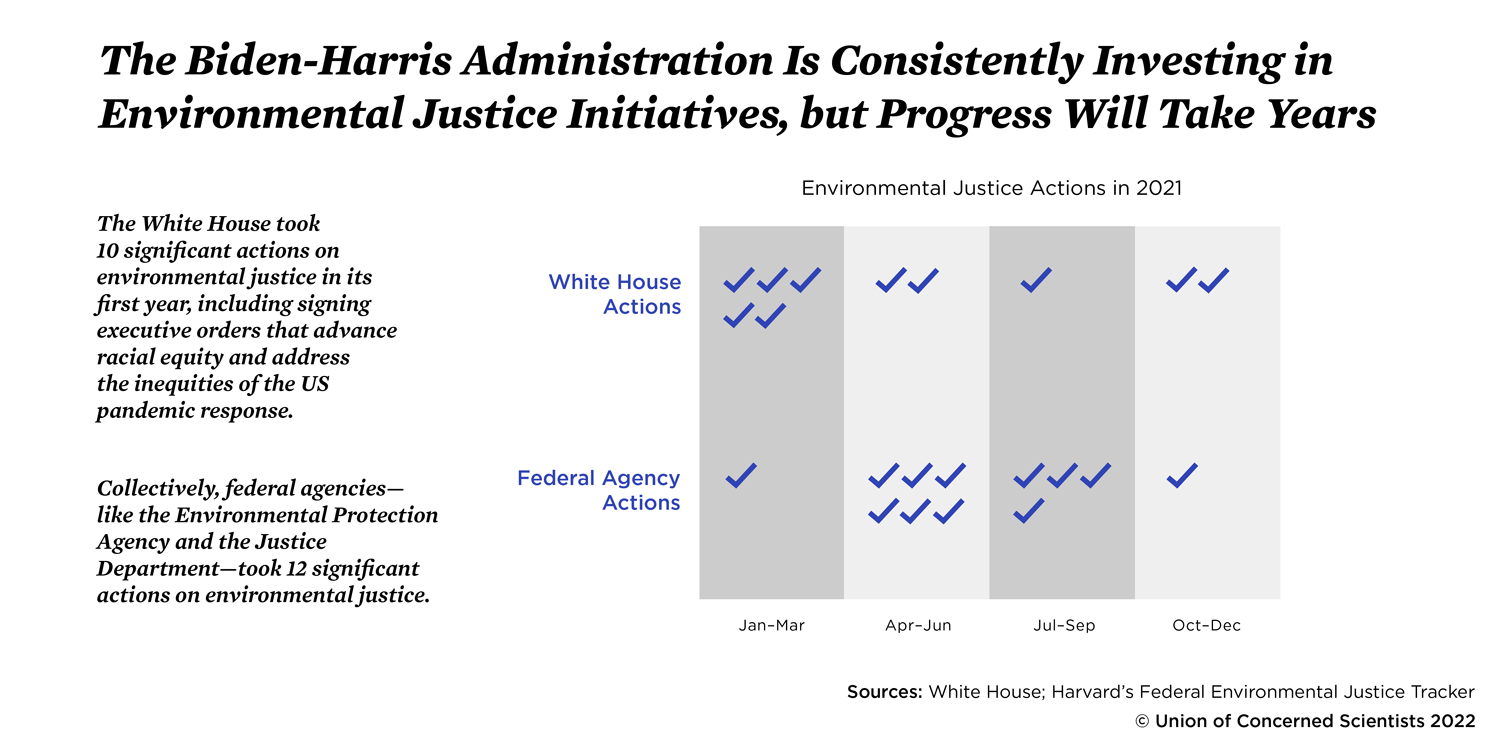
Share this graphic on Twitter | Share this graphic on Facebook
The Biden-Harris administration has committed to addressing long-standing injustices that face underserved communities across the nation, with commitments that surpass those of any prior presidential administration in modern history. However, these initiatives must be implemented thoroughly, fairly, and with community input; whether this will happen remains to be seen, and it is still too early to say whether the administration will deliver on its promises.
Read More: Biden's Actions on Environmental Justice
Centuries of exclusionary practices in science, medicine, and governance have saddled Black, Indigenous, and other people of color, as well as rural and low-income communities, with disproportionately high exposure to pollution, less access to healthcare, and less representation in government. The environmental justice movement seeks to identify and address these inequities, fighting for communities' rights to safety, dignity, and self-determination.
Some prior administrations have implemented significant environmental justice measures. For example, under President George H.W. Bush, the Environmental Protection Agency (EPA) created the Office of Environmental Justice, and President Clinton issued an executive order directing federal agencies to examine the environmental and human health effects of federal actions on low-income communities and communities of color. But the Biden-Harris administration is unique in its efforts to make environmental justice a priority, and President Biden's team has made strong commitments on this front.
The White House Acts on Equity
On his first day in office, President Biden issued an executive order calling for a "whole-of-government" approach to supporting underserved communities. A week later, he issued another, focused on tackling the climate crisis and laying out commitments to environmental justice. On January 27, 2021, the White House released a plan to strengthen scientific integrity across government, noting that political interference in science "contributes to systemic inequities and injustices."
President Biden also appointed members to the newly created White House Environmental Justice Advisory Council, which includes 26 of the nation's top environmental justice leaders and scholars, and formed a COVID-19 Health Equity Task Force to study and combat the deeply unequal outcomes of the pandemic, which has infected, sickened, and killed disproportionately more people of color.
The administration has also sought to diversify the scientific workforce, which skews older, White, and male. In June 2021, President Biden announced efforts to strengthen and diversify the federal workforce, with innovative provisions "to recruit, hire, develop, promote, and retain" talent. This is a vital effort: research shows that diversity in scientific groups strengthens innovation, and more diverse teams—able to draw ideas from a broader cross section of society—achieve better outcomes than homogenous teams. Diversity in government also gives communities more confidence that their government is listening to them, and staff who are Black, Indigenous, and other people of color (BIPOC) can strengthen government decisionmaking by sharing their lived experiences and connection to underserved communities.
Increased Spending on Environmental Justice
So far, the administration has put its money where its mouth is. The administration's American Jobs Plan and the EPA budget have directed billions of dollars toward environmental justice work. The administration also announced the Justice40 Initiative, which promises that 40 percent of the overall benefits of federal climate change and clean energy investments will flow to disadvantaged communities.
In July 2021, the administration released guidance—shaped by a landmark report from the White House Environmental Justice Advisory Council—on how to roll out the Justice40 Initiative. The Council's report includes recommendations for using the Climate and Economic Justice Screening Tool—a federal dataset of metrics such as community demographics and proximity to polluting sites—that can help agencies improve their efforts to work with disadvantaged communities.
Federal Agencies Are Making Bold Commitments
Agencies have acted, too. In April 2021, EPA Administrator Michael Regan declared environmental justice a priority for the agency and called on all EPA offices to work directly with communities burdened by pollution. At the National Institutes of Health, a new initiative seeks to reduce barriers to racial equity in the research workforce, and the Centers for Disease Control and Prevention declared racism a public health threat. The Office of Personnel Management, which manages the federal workforce, is in the process of developing a new assessment tool to help agencies evaluate their efforts to build diversity, equity, and inclusion. The tool will track employees' demographic data, as well as hiring and promotion practices.
Some agencies—like the Department of Agriculture, Department of Transportation, and the National Aeronautics and Space Administration—have sought ideas from the public on how to better integrate equity into their work. Other agencies have held listening sessions with underserved communities, released pollution data to the public faster and more frequently, better enforced environmental laws in communities overburdened by pollution, and carried out policy actions—for example, on chemical safety—that protect the public.
Enormous Problems Require Expansive Solutions
These measures are promising, and if fully implemented, could result in long-overdue progress toward environmental, racial, and economic justice.
But some advocates and scientists remain wary. Decades of systemic environmental racism have hurt underserved communities, particularly Black, Indigenous, and low-income people and people of color, who suffer the worst consequences of climate change, pollution, toxic chemical exposures, and the cumulative effects of long-standing, racist policies. As a result, the Biden-Harris administration faces an uphill battle to chart a new path, one that reverses long-standing damage and centers the voices and experiences of those harmed most. But this difficult path is also a necessary one for protecting the health, safety, and dignity of generations to come.
This section was authored by Anita Desikan, the senior analyst for UCS's Center for Science and Democracy.
Clean Transportation
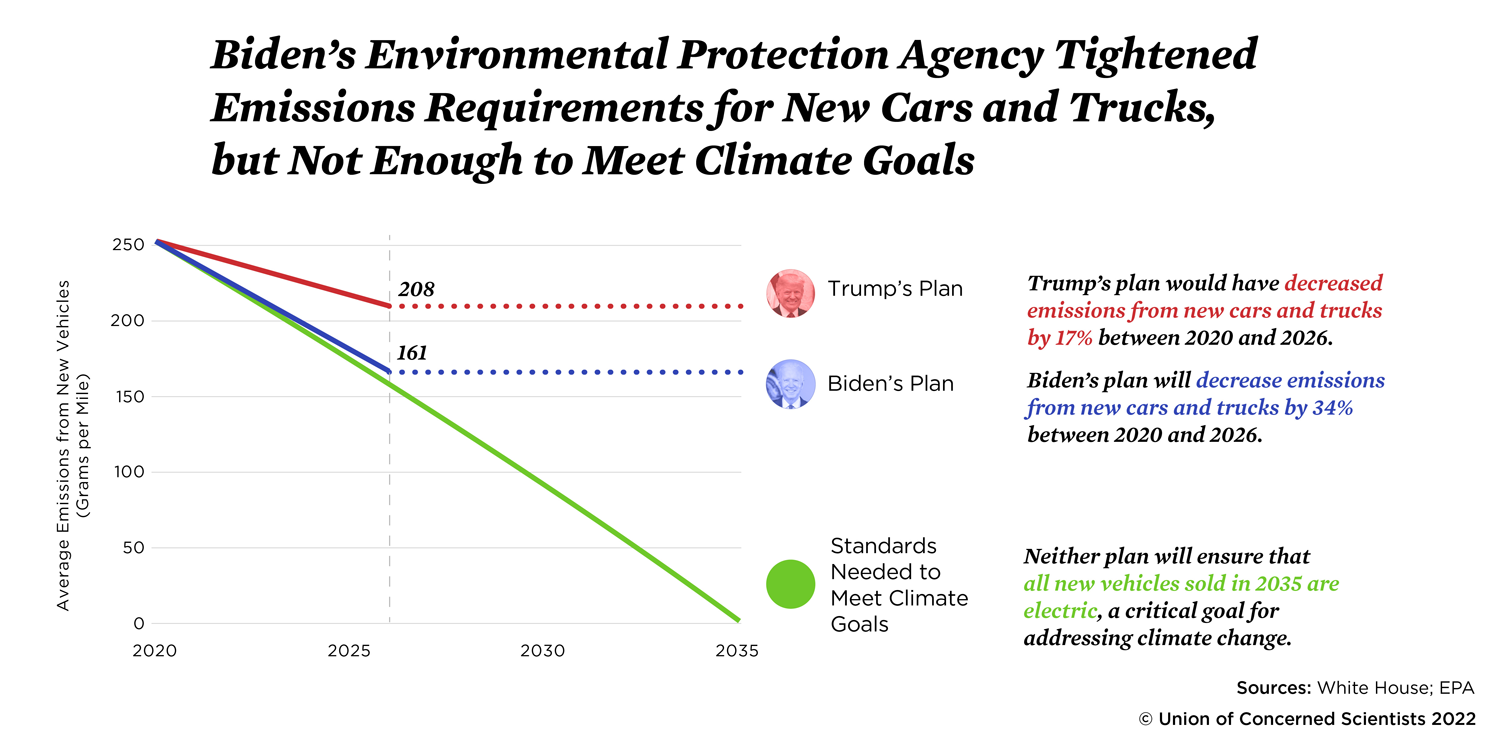
Share this graphic on Twitter | Share this graphic on Facebook
So far in 2021, the Biden-Harris administration has tightened standards for new passenger cars and trucks, worked to undo the previous administration’s rollbacks, and sought to reduce pollution and soot from heavy-duty vehicles. The administration has also announced its goal of ensuring that half of new passenger vehicles sold by 2030 are electric. These are positive steps, but more is needed to plan the long-term, large-scale electrification of the entire transportation sector—a vital step for reducing global warming emissions. To achieve this, the administration should work to ensure that 100% of all new passenger vehicles sold in 2035 are electric.
Read More: Biden's Actions on Clean Transportation
Administration Tightens Vehicle Emissions Standards
On-road vehicles—cars, trucks, motorcycles, buses, etc.—are the country's largest single source of global warming emissions. Because of this, transforming the transportation sector must be central to the federal government's efforts to combat climate change.
So far, Biden's team has made progress on this front. On August 5, 2021, the administration proposed tightening vehicle emissions standards for new cars and trucks, requiring auto manufacturers to cut global warming emissions from new vehicles by one-third by 2026, relative to 2020. While this rule nearly doubles the emissions reductions required by the Trump administration, it is only slightly more stringent than the Obama-era rule finalized in 2012 (and mostly because the new rule covers an additional year of sales). While today's auto manufacturers are investing in electric vehicles, President Biden's rule can be fully met through the sale of more efficient gasoline-powered vehicles—that is better than nothing, but still a problem.
Still, Biden's new rule has benefits. It will save consumers more than $50 billion at the pump, money that can be spent in local economies instead of filling oil companies' coffers. The rule also combats climate change. Over these vehicles' lifetimes, it will reduce global warming emissions by about 440 million metric tons. And because the rule promotes electrification, it could help prevent hundreds of premature deaths (tailpipe pollution kills thousands of people in the United States each year) and save $4 billion in public health costs.
The administration's new emissions rule is an important step. But it must be the beginning, not the end, of the administration's work to electrify the transportation sector.
Biden Directs Agencies to Revamp Emissions Standards for the Long Term
The same day that he announced the new rule for passenger cars and trucks, President Biden issued an executive order outlining a suite of emissions standards to be written by his administration. A proposal for the first of these regulations is likely to emerge in the coming weeks:
- Pollution standards for heavy-duty trucks: The executive order directs the Environmental Protection Agency (EPA) to set new pollution standards for medium- and heavy-duty trucks, basically anything bigger than a Ford F-150 all the way through tractor-trailers. The rule will reduce emissions of smog-forming nitrogen oxide (NOx) from trucks starting in 2027. Additionally, the EPA will strengthen its existing global warming standards for trucks sold between 2027 and 2029 to reflect the significant progress electric trucks (which emit zero tailpipe emissions) have made since those rules were first finalized.
- 2027+ fuel economy and emissions standards for passenger cars and trucks: Biden's executive order also directs the EPA and the National Highway Traffic Safety Administration to set new fuel economy and global warming emissions standards for passenger cars and trucks, starting in 2027, with the aim of electrifying at least half of these new vehicles by 2030.
- 2030+ standards for heavy-duty trucks: Building on near-term standards (#1), the executive order also directs the EPA to set new global warming standards for heavy-duty trucks for 2030 and beyond, standards that could assure a full-scale transition to electric vehicles. However, unlike the passenger vehicle standards (#2), President Biden did not set specific targets.
Because none of the regulatory actions outlined in Biden's executive order have been finalized, we do not know how effectively they will aid a swift transition to electrification. And to meet climate goals, this transition must indeed be swift, with strong action needed over the next 10 to 15 years.
Preliminary Steps to Combat Inequity
Vehicle pollution is linked to asthma, chronic bronchitis, heart attacks, cancer, and early death, but not everyone is affected equally: people of color are disproportionately burdened by the health impacts of our transportation system. This is no accident. Throughout US history, federal, state, and local decisionmakers have built polluting freeways in and through communities of color. As these highways expand, inequity deepens.
The administration has sought to combat this injustice with its Rebuilding America Infrastructure with Sustainability and Equity (RAISE) funding program, managed by the Department of Transportation (DOT). Under the program, the DOT has the discretion to fund infrastructure projects that would have a significant local or regional impact. Many project proposals emphasized the need to remedy the harms of those hurt most by the US transportation system.
So far, the DOT has awarded less than 20 percent of its funding to projects that would increase road capacity for cars and trucks. By comparison, roughly half of the funding—more than $500 million—has been funneled into bike and pedestrian infrastructure, including at least 7 percent toward programs designed to reduce road capacity and promote alternatives like walking, biking, and public transit. The RAISE grants have also prioritized infrastructure upgrades over expansion, evidence of the "fix it first" mantra espoused by Transportation Secretary Pete Buttigieg.
The administration has demonstrated its focus on inequity in other ways. In March 2021, the DOT decided to halt highway expansion in Houston along I-45, citing the need to investigate the project's inequitable impacts on air quality and community displacement.
It will take more time to determine whether these efforts can help correct long-standing transportation injustices, but this is a notable start.
This section was authored by Dave Cooke, a senior vehicles analyst for UCS's Clean Transportation Program.
Food and Agriculture

Share this graphic on Twitter | Share this graphic on Facebook
For decades, the US food system has taken the wrong path. Public policies and market forces have enabled farms to grow larger and more industrialized, driving out smaller farms and discriminating against Black, Indigenous, and people of color (BIPOC) farmers. Unchecked food company mergers and weak enforcement of antitrust laws, combined with economic forces, have created near-monopolies that deny workers adequate protections and shortchange farmers—a reality made starkly visible by the COVID-19 pandemic. In its first year, the Biden-Harris administration has signaled its intent to challenge corporate powers and remedy long-standing racial discrimination in our food system, but these are monumental tasks requiring substantial political will. Time will tell whether the administration will be successful.
Read More: Biden's Actions on Food and Agriculture
The systems that produce and distribute food in the United States are heavily influenced by powerful corporate and political entities—with deeply inequitable results. Food service workers and farmworkers, who are predominantly Black and Brown, earn some of the nation's lowest wages, and jobs in meat and poultry processing, largely held by immigrants, are among the most dangerous. Meanwhile, farm ownership has become concentrated in ever fewer (and increasingly White) hands.
From the beginning, President Biden has promised to make the food system more fair. While this will not happen quickly, the administration has taken steps in its first year to address these troubling trends.
Breaking the Meat Industry's Abusive Power
The meatpacking and poultry industries are emblematic of the food system's inequities and its control by corporate giants. Poultry companies, led by Tyson Foods, have colluded to cheat contract farmers, while processing plants are rife with hazards for workers. A 2017 analysis found that Tyson ranked fourth among all companies, regardless of industry, in severe worker injuries.
In the early days of the pandemic, as meat- and poultry-plant workers and surrounding communities suffered outbreaks, these companies acted badly: refusing to enact adequate safety measures, lying to workers and public health officials, and pressuring regulators to look the other way. A recent congressional investigation identified at least 59,000 COVID-19 infections and 269 deaths among meatpacking workers during the first year of the pandemic—nearly three times more than earlier estimates. At the time, federal safety regulators turned a blind eye.
The industry's abuses arise in large part from a lack of competition: A joint investigation by the Union of Concerned Scientists (UCS) and the Guardian showed that Tyson has a virtual monopoly over the chicken industry in its home state of Arkansas, for example. Such dominance gives Tyson and other giant processors far too much market and political power.
The Biden-Harris administration has taken some steps to address this problem. In July 2021, President Biden issued an executive order aimed at promoting competition in all sectors of the US economy. Over the following six months, the US Department of Agriculture (USDA) announced multiple investments—a combination of grants, loan guarantees, and funds for worker training and technical assistance—to support and expand independent meat and poultry processing to increase competition in this heavily concentrated part of our food and agriculture system. The USDA says this will force big companies to lower consumer prices and provide farmers and ranchers with new local and regional options for marketing their products. In total, the USDA has pledged more than $1 billion in government investments, and it has said that its new Food Supply Chain Guaranteed Loan Program will leverage up to another $1 billion in guaranteed loans from private banks and other institutions to help expand meat and poultry processing and other food-supply-chain infrastructure.
Increased competition in processing could help farmers and ranchers by offering them new market opportunities and higher prices. During a White House press conferencein September 2021, administration officials also bluntly accused industry giants of unfairly inflating consumer prices. Tyson and other companies, they said, have made record or near-record profits since late 2020, even as farmers have lost money and supermarket prices for meat have skyrocketed. According to a White House report, half of the increase in US grocery bills comes from beef, pork, and poultry; beef and pork prices alone saw double-digit increases in 2021. However, economists doubt that investments in processing capacity will make a dent in consumer prices for meat and chicken.
Moreover, the USDA's large investments in alternative meat and poultry processing will not be enough on their own to break the monopoly-like power of the big processors. The USDA has pledged additional bold action to crack down on the industry's abuses and—with a joint announcement in early January 2022—said it will coordinate efforts with the Department of Justice (including new appointees with strong antitrust track records) to step up enforcement of existing laws. We do not yet know the extent to which these efforts will truly challenge the industry's power.
At the same time, the administration has made wrong turns when it comes to protecting meat and poultry workers from corporate giants such as Tyson Foods. To date, the Occupational Safety and Health Administration has not done as much as it could to protect workers from COVID-19. Worse, the USDA seems to have backtracked on plans to prevent line speeds from increasing at meat and poultry plants (faster lines mean more industry profit, but they can also increase worker injuries and make social distancing harder). In November 2021, the department announced a new pilot projectthat would allow faster line speeds at select pork plants. The administration must do better.
Reversing Racial Inequities in Agriculture (and at the USDA)
US agriculture and the USDA have a racial equity problem. Today, while BIPOC people represent more than a third of the US population, they operate fewer than 5 percent of farms and cultivate less than 1 percent of farmland. Moreover, most of the nation's 2.4 million farmworkers, without whom the agricultural system could not operate, are people of color who do not own or operate farms of their own. And as UCS research has shown, the consolidation of farmland into fewer, larger farms has disproportionately pushed out Black farmers.
While these problems date back to slavery and the federal government's efforts to hand millions of acres of Native land to White settlers, discriminatory USDA policies and practices continue to perpetuate inequities. In its first year, the Biden-Harris administration took important steps to right these wrongs.
The administration's COVID-19 stimulus plan (the American Rescue Plan), passed by Congress in March 2021, allotted $4 billion to forgive certain USDA loans taken out by farmers of color. But in June 2021, before funding could be allocated, court challenges by White farmers—backed by political operatives—stalled the program. The administration has since advanced a broader debt relief program, which makes no mention of race but is aimed at "economically distressed" farmers, as part of the Build Back Better Act. The legislation has passed in the House and awaits action in the Senate. Additionally, in September 2021, the USDA announced a new Farm and Food Workers Relief program that will make $700 million in grants to help frontline food system workers—who are predominantly people of color—with health and safety costs related to the pandemic.
The administration is also working to advance equity and inclusion within the federal government. At the USDA, President Biden has nominated people of color to leadership positions, including deputy secretary; undersecretaries for research, food safety, and natural resources and environment; and key senior advisors. In September 2021, Biden's secretary of agriculture, Tom Vilsack, announced that the USDA would establish an Equity Commission to study how the department's programs, policies, and practices exclude people of color and perpetuate disparities. More than 400 organizations and individuals responded to the USDA's request for public inputon how to advance racial equity and support underserved communities—UCS made recommendationsbased on our 2020 assessment in partnership with the HEAL Food Alliance.
The Road Ahead Is Long
Before President Biden took office, UCS called on his administration to make our food system more equitable and sustainable, starting with a 10-step roadmap. The administration's progress in its first year has been promising, but there is a long way to go. In the coming months, Biden's team must take bold legal and regulatory action to rein in Tyson Foods and other agribusiness monopolies. And the administration must continue to aggressively root out systemic racism at the USDA and in our food and agriculture system, working with affected stakeholders to dismantle barriers that marginalized people face in accessing information, participating in programs and services, and benefiting from USDA policies.
This section was authored by Karen Perry Stillerman, the senior strategist and senior analyst for UCS's Food and Environment Program.
Acknowledgments
This report was made possible with the support of the Bauman Foundation, Broad Reach Fund, Democracy Fund, the Doris Duke Charitable Foundation, the Bernard F. and Alva B. Gimbel Foundation, New York Community Trust, the David and Lucile Packard Foundation, the Rauch Foundation, Wilburforce Foundation, and UCS members.
We also thank those who reviewed, created graphics for, and otherwise shaped this report, including Katy Balatero, Felipe Castro, Bill Cotter, Anthony Eyring, Matt Heid, Cynthia DeRocco, Seth Michaels, Andrew Rosenberg, Seth Shulman, and Bryan Wadsworth.
The opinions expressed herein do not necessarily reflect those of the organizations that funded the work or the individuals who reviewed it. UCS bears sole responsibility for the report’s content.
Citation
MacKinney, Taryn, Jacob Carter, Rachel Cleetus, Dave Cooke, Anita Desikan, Jennifer Knox, Taofik Oladipo, and Karen Perry Stillerman. 2022. One Year of Science Under Biden: Tracking the Administration's Progress and Shortfalls. Cambridge, MA: Union of Concerned Scientists. https://www.ucsusa.org/resources/one-year-science-under-biden
